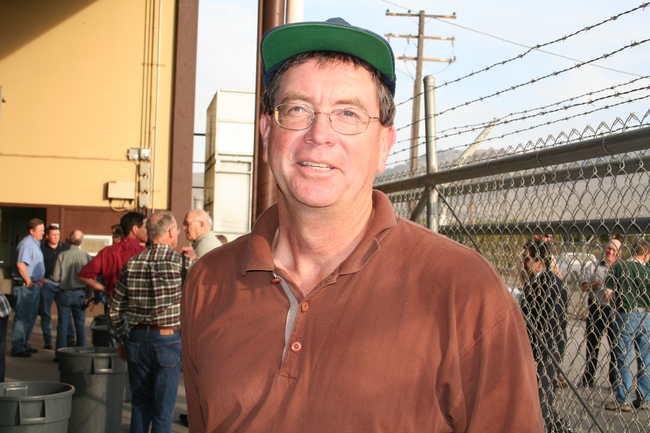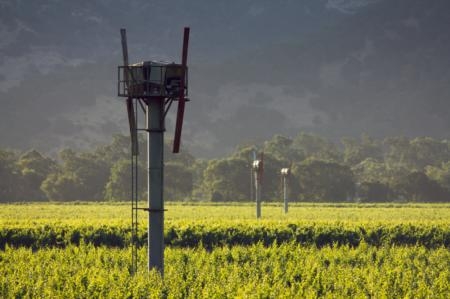
Posts Tagged: freeze
UC study shows promise for protecting coastal winegrapes from frost

“We’ve had some very severe frosts in San Luis Obispo County and on the Central Coast over the years,” said Mark Battany, UC Cooperative Extension advisor in San Luis Obispo and Santa Barbara counties. “In 2011 we had the most severe frost in 30 years and many millions of dollars of crop and wine value were lost because of that freeze.”
Farmers take various measures to protect their crops when temperatures dip below freezing, such as mowing or tilling the vineyard row middles, or running sprinklers with water pumped from underground aquifers or diverted from streams.
“Sprinkler frost protection is very effective in many areas,” Battany said. “The concern we have in California is that water is becoming more limited. We don’t have the ability to easily import water from other areas to our coastal regions, and our local supplies are being stretched quite thin.”
Some farmers are considering wind machines, which mix warmer air high above the ground with air closer to the ground to raise the temperature. But wind machines are expensive, and the potential effectiveness depends on the strength of the temperature inversion. UC scientists are now gathering data to help inform farmers before making the costly investment.
Battany and his colleagues - Rhonda Smith, UCCE advisor in Sonoma County, Richard Snyder, UCCE specialist in the Department of Land, Air and Water Resources at UC Davis, and Gwen Tindula, UCCE staff research associate - are collecting temperature inversion data at different locations in 60 coastal vineyards throughout three counties to document inversions during frost events.
The scientists installed 35-foot-high meteorological towers with data loggers at the top and at the five-foot height to measure the difference in temperature. In the first year of the study, there were useful inversion conditions on nearly three-fourths of the nights when there was frost.
“That’s a fairly good success rate,” Battany said. “The wind machine will provide quite a bit of protection under those conditions.”
The study will continue this year and in 2014. Farmers who wish to install their own meteorological towers with data loggers can do so at a cost of about $250 each. Installation instructions and specifications are available on the UCCE website.
The UCCE research is funded with a grant from the American Vineyard Foundation and a CDFA Specialty Crops Block Grant.
For more details, see the video below:
California citrus farmers weather the freeze
It has been particularly cold at night in California for about a week, but it appears the state's citrus industry will emerge mostly unscathed, reported Oliver Renick on Bloomberg.com.

Thermometers dipped about 10 degrees below normal overnight during the cold snap, but growers efforts to keep the trees warm with wind machines and irrigation appear to have been successful.
"We are not anticipating any damage in the navels, maybe very limited damage on the outer row away from the wind protection,” said Shirley Batchman, the director of government affairs at California Citrus Mutual. “Certainly nothing that’s going to affect the orange production.”
Central Valley farmers battle cold nights

From Dec. 3-10, temperatures dropped as low as 31 degrees in Fresno, 26 degrees in Madera, 27 degrees in Merced, 26 degrees in Napa, 25 in Redding and 27 in Redbluff. Growers in these areas were working to avoid damages like those suffered in 2007, when a freeze caused more than $1.4 billion in damage to citrus, avocados, strawberries, vegetables, nursery stock and other crops, the article said.
In northern areas, freezes blackened the tips of some young walnut tree branches, but those are generally pruned off anyway, said Rick Buchner, a University of California Cooperative Extension farm advisor in Red Bluff, Calif.
"There's been no serious damage in the big wood that I've been called to look at yet," Buchner said.
Storm system unlikely to freeze citrus
Newspapers up and down the state are covering the cold storm system approaching California. In addition to reporting the weather, Sacramento Bee reporter Loretta Kalb took the time yesterday to check on the impact of the storm on California citrus.
Even though it was Sunday afternoon, UC Cooperative Extension Butte County farm advisor Joe Connell contacted Kalb to tell her citrus crops should emerge with little or no damage from the week's storm.
"As far as citrus goes, for the naval orange, it takes about 3.5 hours at 26 degrees for the first orange to freeze," Connell was quoted in the story. "The orange juice itself has high sugar. It's like an antifreeze in the fruit. If it's colder, down to 25 degrees, after about an hour you'll get 5 percent of the fruit frozen."
At 27 degrees to 28 degrees, the low temperature forecast for most parts of the Valley, "I think most of the (citrus) fruit will be fine," Connell told Kalb.
The Redding Record Searchlight ran a story advising homeowners to protect their freeze-sensitive plants in the face of the winter storm. Citrus trees may be protected by a sheet or blanket, or as retired UC Cooperative Extension farm advisor in Fresno County Mark Freeman typically suggested this time of year: Wrap the tree in good, old-fashioned Christmas lights. They'll keep the tree warm and look festive at the same time.
More information from UC Cooperative Extension about citrus freeze protection and damage is available in a citrus freeze media kit.

A citrus tree damaged during a freeze.
Baby, it's cold outside
The San Joaquin Valley is bracing for a hard freeze predicted to strike tonight and tomorrow morning, putting the Valley's $1.3 billion citrus industry on high alert. Whether farmers will have to spring into action depends on a lot of things, such as cloud cover, according to Joel Nelson of California Citrus Mutual, who was quoted in today's San Francisco Chronicle.
"But we will have the wind machines primed and many of them on from 8 p.m. to 7 a.m.," Nelson is quoted.
The Bakersfield Californian turned to UC Cooperative Extension farm advisor John Karlik for advice for homeowners worried about potential freeze damage to landscape plants. He said residents within the city limits can rest fairly easy this week, but those who live in the slightly colder, outlying areas may need to take added precautions.
According to the article, he suggested homeowners bring tropical and sub-tropical plants inside, if possible, and cover outdoor plants overnight using plastic, cloth or newspapers. Watering the plants during the day will help preserve heat at night.
For more details on protecting your garden from frost, see this article by Pam Geisel, the academic coordinator for the UC Master Gardener program.
A note about the headline: The Valley, of course, is rarely as cold as New York, where Frank Loesser wrote the song "Baby, It's Cold Outside" in 1944, but the music still rings in the ears of Californians when an artic air mass descends on the state. A cute version of the song by Doris Day and Bing Crosby is one of many posted on YouTube.

A citrus tree that was coated with water for frost protection.
